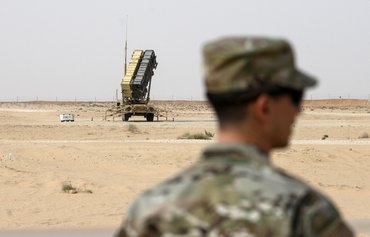The US military's Patriot system -- a long-range, all-altitude, all-weather air defence system that counters tactical ballistic missiles, cruise missiles and aircraft -- is positioned to defeat any attempt by Iran to launch ballistic missiles in the event of a regional conflict.
Since it was first fielded, the Patriot system has been used by five nations in more than 250 combat engagements against manned and unmanned aircraft, cruise missiles and tactical ballistic missiles.
Since January 2015, the Patriot has intercepted more than 150 ballistic missiles in combat operations around the world.
Each Patriot launcher can fire 16 missiles and target eight inbound ballistic missiles, using the two-shot method that aims to guarantee destruction of the target.
A Patriot battery of six launchers can defeat 48 ballistic missiles, which represents an estimated one-third of Iran's short and medium range launch capability.
Reload capabilities for the Patriot are also a fraction of the time it takes Iran to reload a ballistic missile launcher.
The US Army considers a one-hour reload time the minimum standard for effective battlefield readiness. The Patriot system requires a highly technical level of training to relocate and reload under pressure.
"We usually have the weapon system fully reloaded in under 45 minutes, but my crew has gotten this down to around 30 minutes consistently," Sgt. Edward Han, a reload crew leader, said during a safety and readiness training exercise in 2016.
History of Iranian mishaps
Adding to the calculations during any potential conflict is the history of Iranian blunders.
From failed satellite launches to the fatal downing of Ukraine International Airlines Flight 752, Iran's Islamic Revolutionary Guard Corps (IRGC) has a long history of missile failures, embarrassments and tragedies.
Insufficient attention to missile safety protocol, dilapidated equipment and outdated technology have contributed to this track record of failure.
Iran's record, particularly over the last decade, shows callous disregard for safeguards and for proper use and training with regard to its ballistic missile technology.
According to a retired Iranian navy analyst, most of Iran's military technology is reverse engineered or purchased from Russia, China or North Korea.
"None of these countries provides sufficient training or support to ensure safety," said the analyst, who asked to remain anonymous.
US sanctions have slowed Iran's drive to become a nuclear power considerably and hampered its missile programme as a consequence, yet the regime continues to spend millions on missile technology.
Iranian missile base vulnerable
An Iranian facility crucial to the regime's ballistic missile operations, the Imam Ali Missile Base -- which lies 35km west of Khorramabad in Lorestan province, western Iran, and is under the control of the IRGC -- already is vulnerable to US precision weapons should the need arise amid heightened tensions between Iran and the West.
Iran has placed stiff air defences around the base to deter any attack by an air force, including Sky Guard artillery and anti-aircraft missiles, according to the Iran Watch site.
Such an attack, especially if carried out by manned bombers, would carry risk.
However, the US military has capabilities that reduce the potential danger to US personnel if it receives orders to strike distant bases.
These capabilities come in the form of the US Army's Army Tactical Missile Systems (ATACMS), which have a range of up to 350km, and can either be launched from a Multiple Launch Rocket System (MLRS) or a High Mobility Artillery Rocket System (HIMARS).
They carry 227kg warheads, according to US Defence Department and Lockheed Martin data.
Using them eliminates the need to send pilots and other crew over a heavily defended missile base.

![A single US military Patriot battery could shoot down about one-third of Iran's short and medium range ballistic missiles. [Raytheon]](/cnmi_am/images/2021/10/11/31974-patriot-battery-system-600_384.jpg)






